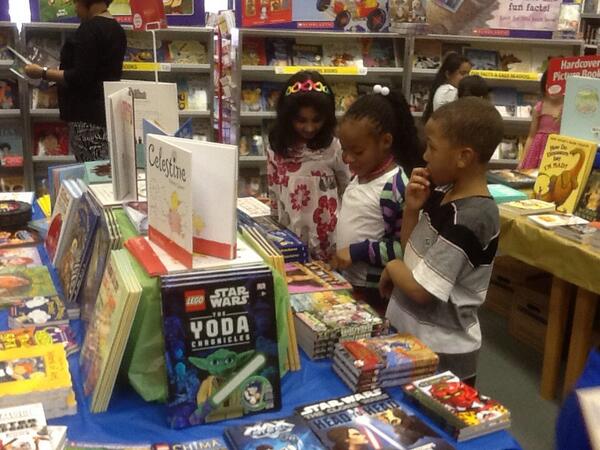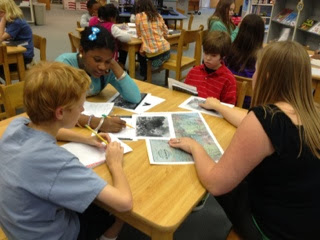Mrs. Derby's 2nd graders learned how to create Glogs this week to share what they learned from their Sound unit. Each pair planned their poster with 3-4 facts, plus a description of how a musical instrument creates sound.
Friday, December 20, 2013
Sunday, December 8, 2013
Book Fair!!
The Book Fair is back at Club Boulevard! All monies raised from this fair will go towards hosting our Author of the Month for February, Carole Boston Weatherford, at Club Boulevard. The Book Fair will be open every morning this week at 8:15am, as well as every afternoon, during Grandfriends' Luncheon and on Thursday evening for the PTA meeting and Chorus concert. Families can also shop online at this link: http://bookfairs.scholastic.com/homepage/clubblvd
Thank you for supporting the Media Center and our students!
 |
| First graders check out all the great books at the fair! |
Thursday, December 5, 2013
Primary Sources
(Guest post from media center intern Tisha Woo):
"Google.” “Wikipedia.” “WebPath Express.”
"Google.” “Wikipedia.” “WebPath Express.”
When asked how they typically find out information for a project in school, these are the responses I received from the fifth-graders in Ms. Roach's class. I would guess many students would answer similarly regardless of what school they attend or grade they are in. Finding quick answers on the Internet is widespread among both students and grown-ups!
These same fifth-graders spent time with me in the media center this week learning how to research the Westward Expansion using primary sources from the Library of Congress.The Library of Congress provides primary source sets of different topics in history, plus analysis guides and research tools.
As a group we first defined what primary sources are: information that comes directly from a time in history, created by people from that time. We then made guesses about the Westward Expansion by just thinking about the words “west” and “expand.” Finally, we analyzed together a painting from that time period, “American Progress.” We asked, What do we notice first? What people and objects do we see? What is happening in the painting? What might these things tell us about the Westward Expansion?
 Afterwards, students were divided into groups and cycled through several stations. Each station had a different primary source featuring a different people group from the Westward Expansion. These included women pioneers (an interview), homesteaders (a letter from a pioneer to his wife back East), Native Americans (a photograph of three warriors), African-Americans (an interview and a travel log), and others.
Afterwards, students were divided into groups and cycled through several stations. Each station had a different primary source featuring a different people group from the Westward Expansion. These included women pioneers (an interview), homesteaders (a letter from a pioneer to his wife back East), Native Americans (a photograph of three warriors), African-Americans (an interview and a travel log), and others.
 Afterwards, students were divided into groups and cycled through several stations. Each station had a different primary source featuring a different people group from the Westward Expansion. These included women pioneers (an interview), homesteaders (a letter from a pioneer to his wife back East), Native Americans (a photograph of three warriors), African-Americans (an interview and a travel log), and others.
Afterwards, students were divided into groups and cycled through several stations. Each station had a different primary source featuring a different people group from the Westward Expansion. These included women pioneers (an interview), homesteaders (a letter from a pioneer to his wife back East), Native Americans (a photograph of three warriors), African-Americans (an interview and a travel log), and others.
Students studied the primary source in their small groups, identified what they noticed, and looked for keywords, which they recorded on two-column research sheets. Students at the song sheet center could be heard putting the verses to their own tunes; students studying Native Americans wondered about why warriors were holding women’s hats and wearing plaid shirts; and students who read the interview with an African-American cowboys talked about who they thought “the Vigilantes” might be.
It was a challenging process for these students to learn history directly from these sources, but as we concluded our research, students shared what they enjoyed:
“The information came right from that time period.”
“You knew you were learning about a real person.”
“The sources were more reliable than what you can find searching Google.”
The students also concluded it would be beneficial to study other topics using primary sources. I enjoyed seeing their understandings about information and research grow through this experience!
 |
| Freewriting in our journals after concluding our research. |
Wednesday, December 4, 2013
Story Squad
3rd graders were lucky to have a visit by UNC's Story Squad this afternoon! To support their study of space in the classroom, we invited the Story Squad to share 'stories from the sky' with us. What is Story Squad you ask? It is a group from the School of Information and Library Science at UNC dedicated to bringing world folklore into schools, public libraries, day care centers, senior centers, and other cultural institutions. Read all about their Mission, Vision, and past/upcoming activities here: http://storysquad.org/
We thoroughly enjoyed tales of the lazy coyote decorating the heavens with pieces of an unknown shiny material that becomes stars; two stories about the Milky Way: one about Lindu, daughter of the Sky King, who searches for a husband and decides on the Northern Lights. She weaves her wedding veil while waiting for her husband to arrive, but he never does, so her bridal veil spans the sky; and a Hawaii’an story of the hero Ka’ulu who vanquishes myriad foes as he rescues his kidnapped brother from the Chief of the Sharks, whom he throws into the sky to become the Milky Way. We learned that stories like this can be found in the non-fiction section of our Media Center in the 398.2s!
Thank you, Story Squad, for sharing your talents with us!
 |
| Dr. Brian Sturm (founder) with 3 storytellers from the squad! |
Thank you, Story Squad, for sharing your talents with us!
Tuesday, December 3, 2013
Weather in K/1!
Students in Mrs. Childress' K/1 class visited the Media Center last month to do weather research. For many students, it was their first time visiting the Media Center to do something other than check out books. We learned that the Media Center is a GREAT place to discover and learn new things! We also learned that good researchers write down what they learn to help them remember. Each group chose the weather event they wanted to learn about and we used PebbleGo to find the information. The topics selected were: drought, blizzard, tornadoes, rainbows, and rain. The students did a good job finding words all about their weather topic!
Energy
In November, Mrs. Hayes' 4th graders visited the Media Center to research the basic forms of energy: light, heat, mechanical, and magnetic. I began by introducing the Super 3 Research Process that the students will use this year to help them organize and problem-solve their learning. The steps of the Super 3 are "Plan, Do Review!"
Next, students visited the Media Center in small groups to conduct their research. They had 4 tasks to answer:
How does this form of energy work (define)?
Real World Examples.
Keywords needed to understand the form of energy.
Draw and label an example.
Students accessed information using the desktop computers and iPads. For most students, it was their first time scanning QR codes on the iPad. We learned that QR codes are an easy tool to get us to a website quickly! We found information by reading articles on WorldBook, NCWiseOwl, and by watching videos on Discovery Education and Scholastic Studyjams. The students took the information gathered back to class and created group presentations to teach each other about their form of energy. Students agreed that learning from various text and media, as well as using different tech tools was fun!
Check out our learning in action below!
Next, students visited the Media Center in small groups to conduct their research. They had 4 tasks to answer:
How does this form of energy work (define)?
Real World Examples.
Keywords needed to understand the form of energy.
Draw and label an example.
Students accessed information using the desktop computers and iPads. For most students, it was their first time scanning QR codes on the iPad. We learned that QR codes are an easy tool to get us to a website quickly! We found information by reading articles on WorldBook, NCWiseOwl, and by watching videos on Discovery Education and Scholastic Studyjams. The students took the information gathered back to class and created group presentations to teach each other about their form of energy. Students agreed that learning from various text and media, as well as using different tech tools was fun!
Check out our learning in action below!
Subscribe to:
Posts (Atom)
































